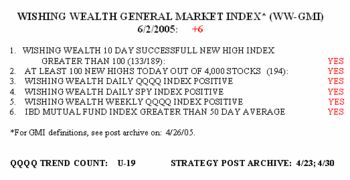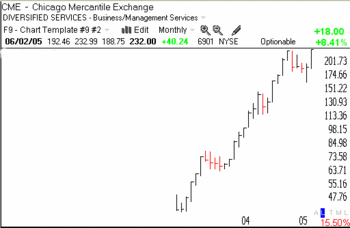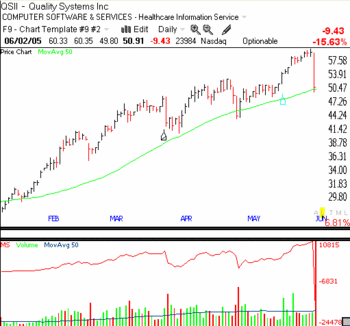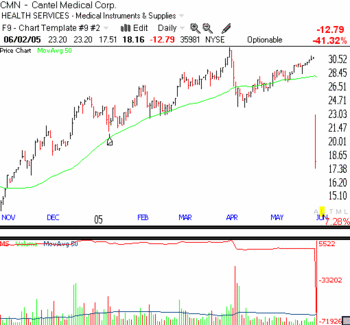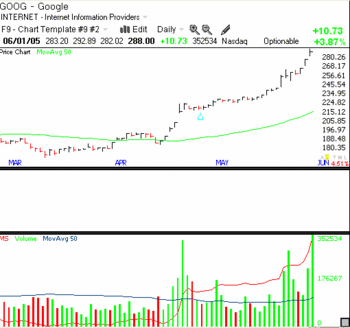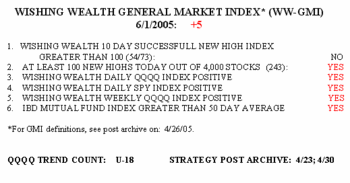To my visitors: I am only one trader, not a guru, and not a financial advisor. I am presenting my own opinions and my own experiences and people are welcome to decide for themselves what, if anything, on this site is of value to them. Please refer to the additional comments, highlighted in red, at the end of this post.
Friday’s decline does not alter my current strategy at all. The GMI reflects relatively long term trends that last weeks or months, not days. It would take a huge decline (4%) in the QQQQ, to below 36.50 to make me question this uptrend.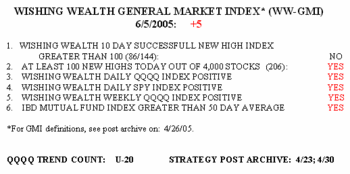 The QQQQ closed Friday at 38.10. The GMI did decline 1, to +5, because there were fewer than 100 (86) successful 10 day new highs. There were almost no (9) successful 10 day new lows. ( See post from 4/26 for definitions of GMI components.) There were 206 new highs and only 22 new lows among my universe of 4,000 stocks. Still, the stocks in the major indexes were weaker than they have been in weeks. Only 14% of the Nasdaq 100 stocks rose on Friday, 26% of the S&P 500 stocks and 7% of the Dow 30 stocks. We are in day 20 (U-20) of the QQQQ up trend……………………………………………
The QQQQ closed Friday at 38.10. The GMI did decline 1, to +5, because there were fewer than 100 (86) successful 10 day new highs. There were almost no (9) successful 10 day new lows. ( See post from 4/26 for definitions of GMI components.) There were 206 new highs and only 22 new lows among my universe of 4,000 stocks. Still, the stocks in the major indexes were weaker than they have been in weeks. Only 14% of the Nasdaq 100 stocks rose on Friday, 26% of the S&P 500 stocks and 7% of the Dow 30 stocks. We are in day 20 (U-20) of the QQQQ up trend……………………………………………
A lot of my current profitable holdings are stocks in triple digits (GOOG, CME, SHLD). I wanted to share with you a realization I had in the strong market in the late 90’s. I found that it was easier for me to trade expensive stocks profitably than cheaper stocks. I know what you are thinking. Price does not matter, only the percentage move is important. But wait a minute. Let’s assume that the typical stock moves up about 20% or so before consolidating. Twenty percent of a $10 stock is two dollars. But I told you that I like to trade by making a small pilot buy and then buying more as a stock rises. A two point move simply does not give me the time and confidence to accumulate a rising stock. But a 20% move in a $100 stock is 20 points, plenty of time for me to get in as the trend develops. Even though the percentage moves of the $10 and $100 stock are identical, the psychological impact of the rise on me is very different. 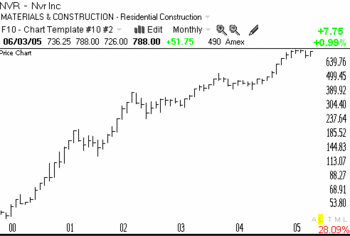 Moreover, another advantage to trading expensive stocks is that I suspect that they are less likely to be manipulated by traders than the cheapies. These in-and-out day traders just do not have the means to plunge in and out of the triple digit stocks with enough shares to influence the price or volume. The chart patterns are therefore likely to be more reliable. (See NVR monthly chart as an example.) Finally, the fact that a stock has experienced enough demand to raise it to triple digits is a good predictor of future demand. So, I love to buy stocks that are $80 or above. They often sprint to $100 or more……………………………..
Moreover, another advantage to trading expensive stocks is that I suspect that they are less likely to be manipulated by traders than the cheapies. These in-and-out day traders just do not have the means to plunge in and out of the triple digit stocks with enough shares to influence the price or volume. The chart patterns are therefore likely to be more reliable. (See NVR monthly chart as an example.) Finally, the fact that a stock has experienced enough demand to raise it to triple digits is a good predictor of future demand. So, I love to buy stocks that are $80 or above. They often sprint to $100 or more……………………………..
I ran a scan of the market for some potential rockets. These stocks have all doubled in the past year, have good recent earnings and are near their all time highs. They also have recent MoneyStream (a TC2005 proprietary indicator like on balance volume) values of 100%. I think that these stocks are worthy of my consideration for future purchases: NSI, SWN, SHLD, NDAQ, CRYP, CME and MW. (I already own some of these.)………………………………………………
The moving average is probably the most important tool in my technical arsenal. Being a research psychologist, I conceptualize moving averages differently than your typical trader. I thought I would share some of my ideas with you. Social scientists typically collect information from a sample of persons and describe the results in terms of the average of the sample. Thus, one might measure the IQ of each person in a class (our sample) and then add all the scores together and divide by the number of students in the class to obtain the class average. If you came into the same classroom and I asked you to guess the IQ of a student "X" in the class and I told you the average IQ for the class was 100, you would have the most likelihood of guessing correct if you guessed that student "X’s" IQ was 100, the class average. For any sample, the best prediction of a sample member’s score is the average of the sample.
Now, consider we design a sample to consist of the closing prices of a stock for the last 5 days. We could add together all of the closes from the past 5 days and divide by 5 to get the average close for the sample of 5 days. As in the example of IQ scores above, the sample average is the best guess of the close for any of the 5 days in the sample. But note that the average remains the same, regardless of the order of the closing prices from the last 5 days. For example, the average of the daily closes: 8,8,6,6,7= 8+8+6+6+7=35/5=7. But if the 5 daily closes occurred in a different order ( for example:8,8,7,6,6 or 6,8,7,6,8) the total of the closes always adds to 35, and when divided by 5, gives the same average = 7. So the average tells us nothing about the order of the closes in the days making up the average.
Now, social scientists know that the number of persons or cases in a sample is very important to determining the usefulness of the sample average that is computed. If I want to estimate the average IQ in a group of 100 people, I may have more confidence if I sample 30 people than 5 people. The average based on 5 people may be very biased and unrepresentative of the 100 people, compared to an average based on 30 of the 100 people. (We scientists sample a small number of people because in most cases we cannot obtain measurements of all of the people–the population– we want to study. For example, voter surveys may select 3,000 people to interview to obtain an estimate of future election results for the entire country.)
Question–how many days’ closing prices do we need, to get an accurate summary estimate of a stock’s closes? Do we compute an average of 5 days, or 10 days or 50 days or 200 days or more? Most technicians compute an average of 50 or 200 days (or periods) without any justification for choosing a sample of that many days. If anyone has seen a published rationale for why so many people choose 50 and 200 day samples to compute averages please let me know. I can find no reason other than tradition. I believe that it is much better to compute an average based on the number of days that produces an average that works for a particular stock, not on some arbitrary standard.
The only difference between the average and a moving average is that the moving average continually changes the sample of closes. In a sense, we choose a new sample each day. A moving average of 10 days consists of the last 10 days’ closes for a stock as of today. Tomorrow, we drop from the sample the closing price from 11 days ago as we add in the current day’s close. Thus in a moving average the order of the days is important in determining which day to drop from the sample. But, again, the resulting average is the same regardless of the order of the days within the sample.
Some people are bothered by the fact that all of the days in the sample count equally in the average. They think that the closes from the more recent days should count more than the earlier days and they weight the recent days’ closes more using exponential weights or some other set of weights. I prefer to use the simple moving average, because it works, and because I think the differential weighting of the days contradicts the whole idea that we are just computing the average of a sample of closes. The final fact you need to know about moving averages is that the only way a moving average changes is if the new day being added to the sample is different from the day being dropped. (If the oldest day to be dropped and the new day to be added have the same close, the sum of the closes does not change and therefore the average remains the same.) Thus, a moving average of 10 days increases only if the current day’s close is greater than the close 11 days ago that is being dropped from the sample. Now this is a most important point. It means that in addition to the value of the moving average, we should pay attention to its direction.
Say stock XYZ is trading at 25 and its 30 day average of its closes is 25. Do we want to own a stock where its current price is the same as its average price over the past 30 days? I think not. I would think that a rising stock should close today above its average price over the past 30 days. Second, is the moving average rising? Remember, in order for its 30 day moving average to be rising, the close today must be higher than the close 31 days ago. Why would I want to own a stock with a flat or declining 30 day average? Don’t I want to own a stock that is at least closing higher today than it closed 31 days ago?
To summarize my strategy rules: 1) One needs to pick a period for computing a moving average based on how useful the resulting average has been for tracking that stock’s prior price trends; 2) The stock should be trading above the moving average that we select; and 3) The moving average must be rising. If you want to know more about the benefits of using moving averages for tracking trends, see Weinstein’s classic book. It is a simple strategy, but oh so valuable. Weinstein’s recommended moving average techniques have helped me to time most bull and bear market moves since 1995.
Did any of this description of moving averages make sense to you? Send me your questions and feedback at silentknight@wishingwealthblog.com
Please remember that the stock market is a risky place, especially now. I am not providing recommendations for you to follow. My goal is to share tools and methods that I have used over the past 40 years of trading, so that you may learn from them and adapt them to your trading style and needs. While I do my best, I do not guarantee the accuracy of any statistics computed or any resources linked to my blog. Please consult with your financial adviser and a mental health practitioner before you enter the stock market, and please do not take unaffordable risks in the current market environment. See the About section for more statements designed to protect you (and me) as you navigate this market. Past performance does not guarantee future results, but I would rather learn from a former winner than a loser.
